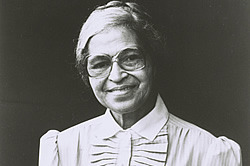Rosa Parks

Overview
This resource is a Social Studies student activity that utilizes Utah's Online Library resources - specifically, Gale's Kids InfoBits Grades K-6, Gale's Research in Context 6-8, Gale's Reference Collection Grades 9-12 - to help students learn about Rosa Parks.
About Utah’s Online Library
Utah's Online Library provides Utah educators and students free access to high-quality reference collections.
This activity was designed to help educators utilize this amazing resource in their classrooms.
Note: Utah educators and students visiting Utah's Online Library from a school computer should be automatically authenticated. When at home, students must use the home access login that their teacher or school media specialist can provide. Utah educators can use either their my.uen login or the home access login.
Activity
Essential Question: How did Rosa Parks's refusal to give up her seat on the bus eventually impact segregation laws? Can one person make a difference?
Rose Louise McCauley, born in 1913 in Alabama, spent much of her younger years living with her maternal grandparents who had both been slaves. She married Raymond Parks when she was still in high school. He was a barber and an advocate for civil rights. When Rosa graduated from high school in Montgomery, Alabama, she became a seamstress. Both she and her husband were members of the NAACP, and she was active in that organization. She helped African Americans register to vote. She worked with youth groups to teach them how to be advocates for African Americans. She refused to drink out of drinking fountains that were designated for blacks only.
How was Rosa Parks influenced by Claudett Colvin? What kinds of similar events took place in both of their lives?
On December 1, 1955, Rosa took her most famous stand for the rights of African Americans. The law on busses was that African Americans had to sit in the back of the bus. They also had to give up their seat for a white person if the bus was crowded. Bus seats usually were wide enough for 3-4 people to sit there. If a white person wanted the seat, all 3 or 4 African Americans had to relinquish the seat so that the white person did not have to sit next to a black person. As Rosa was coming home from work on December 1st, the bus became very crowded. A white man had no place to sit. The bus driver approached the seat where Rosa and 3 others were sitting and told them to stand so that the lone white man could have that seat to himself. Three of the African Americans stood up. But Rosa did not. She slid over in the seat and indicated that there was room for the white man to sit as well. The bus driver insisted that she move, but she continued to refuse. The police were called, and Rosa Parks was arrested.
The NAACP bailed Rosa out of jail, and encouraged her to attempt to fight the charges in court. They organized a citywide boycott and encouraged all African Americans to not ride Montgomery city busses until the law was changed and African Americans were given the same rights on busses as white riders. The boycott was successful. Many of the city busses had few riders. It was inconvenient for the African American community to walk, carpool, and find other methods of transportation, but they persisted.
What role did Martin Luther King play in the Montgomery bus boycott? Who were some of the other women who were arrested for refusing to give up their seats on busses? How long did the bus boycott continue? What were the results of the court case? How did the boycott affect other cities and communities as they fought for civil rights? What was Rosa's life like after the boycott and court case? What contributions did Rosa Parks make through her later years and until her death in 2005?
Utah's Online School Library has many resources for students to discover more about Rosa Parks. The Library of Congress (the link is in Utah's Online School Library in the section called General Resources) has hundreds of photographs of Rosa Parks available online for students to use as part of their research. Gale's Kids InfoBits Grades K-6 has images, book excerpts, and over 100 magazine articles about Ms. Parks that are at a reading level for primary-aged students. Gale's Research in Context Grades 6-8 contains biographical information, images, newspaper articles, and more than 300 magazine articles. In Gale's Reference Collection Grades 9-12, students can choose the Biography in Context database, the Virtual Reference Library, InfoTrac Student Edition, and Student Resources in Context to locate detailed information about Rosa Parks. These databases also are excellent resources to learn more about the Montgomery Bus Boycott and the Civil Rights Movement.
Curriculum Connections:
Social Studies - 5th Grade
Social Studies - 6th Grade
Social Studies - Utah Studies
Secondary - Social Studies - U.S. History II